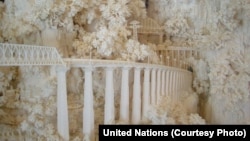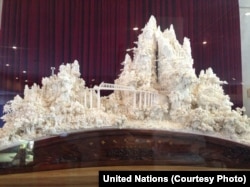An intricately carved model of China’s Chengdu-Kunming Railroad bridge graced the United Nations' New York headquarters for nearly four decades, until renovation of its General Assembly began in 2013 and the sculpture was removed for safekeeping.
There’s a good chance it may never return.
The model train has been sidetracked to the U.N. Chinese mission because it carries the baggage of having been carved from ivory, a substance that has fallen into disfavor. An international trade ban on the ivory trade was imposed in 1989 in an effort to discourage poachers from killing endangered elephants, rhinos and walruses for their tusks.
Gift from China
The People's Republic of China had presented the sculpture to the U.N. in 1974, in gratitude for the country’s acceptance three years earlier as a permanent member of the Security Council.
"My understanding is the ivory gift won’t come back, but you have to ask the Chinese government for the details," Werner Schmidt, spokesman for the U.N. capital master plan, told VOA.
The Chinese mission in New York did not respond to several phone calls and voicemail messages. But an official who asked to remain anonymous confirmed that the sculpture was at the mission, which is not open to the public.
"On my level, I don’t have any information about whether the gift will come back to the U.N., stay in here or go back to museums in China," the official said. "Maybe the higher officials have made a decision, but I don’t know that."
The sculpture depicts part of the railroad stretching 1,135 kilometers across southwestern China from the provinces of Sichuan to Yunnan, according to a website associated with the University of Southern California. The actual railway, constructed from 1958 to 1970, spans difficult terrain and reportedly claimed the lives of at least 1,000 workers.
But the sculpture depicts people dancing and singing along the route. It took craftsman Wang Suwen and roughly 400 other artists at least a year to create the work, which measures 150 centimeters long and 110 centimeters tall, weighing more than 150 kilograms, according to a U.N. description. The design required eight elephant tusks.
The Wildlife Conservation Society estimates ivory trafficking and poaching kills 35,000 African elephants a year.
"It is people from China and Hong Kong [who] like this stuff best," a Chinese staff member at the U.N., who asked to remain unnamed, told VOA. "It is unnecessary for China to be stigmatized by this."
The Chinese government "should ban this like they ban drugs. Even though China’s customs has begun to ban ivory products, their punishments are not enough," the staff member said. "They should make regulation of ivory with more severe punishments."
Crafted in a more lax era
The ivory trade was booming in the early 1970s, when the piece was made, and China remains a leading market. But in May, authorities announced the country would clamp down on the illegal ivory trade.
Britain’s Guardian news site quoted Zhao Shucong, head of China’s State Forestry Administration, as saying the country would "strictly control ivory processing and trade until the commercial processing and sale of ivory and its products are eventually halted."
Vintage ivory can be sold in the United States if its owner can document it arrived in this country before 1990.
As for the ivory Chengdu-Kunming Railroad model, its final stop is unclear.
This report was prepared in collaboration with VOA’s Mandarin service. VOA’s Carol Guensburg contributed to the report.










